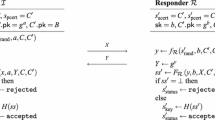Abstract
In the pre-specified peer model for key agreement, it is assumed that a party knows the identifier of its intended communicating peer when it commences a protocol run. On the other hand, a party in the post-specified peer model for key agreement does not know the identifier of its communicating peer at the outset, but learns the identifier during the protocol run. In this paper we compare the security assurances provided by the Canetti-Krawczyk security definitions for key agreement in the pre- and post-specified peer models. We give examples of protocols that are secure in one model but insecure in the other. We also enhance the Canetti-Krawczyk security models and definitions to encompass a class of protocols that are executable and secure in both the pre- and post-specified peer models.
Preview
Unable to display preview. Download preview PDF.
Similar content being viewed by others
References
Bellare, M., Rogaway, P.: Entity authentication and key distribution. In: Stinson, D.R. (ed.) CRYPTO 1993. LNCS, vol. 773, pp. 232–249. Springer, Heidelberg (1994), http://www.cs.ucdavis.edu/~rogaway/papers/eakd-abstract.html
Boyd, C., Mao, W., Paterson, K.: Key agreement using statically keyed authenticators. In: Jakobsson, M., Yung, M., Zhou, J. (eds.) ACNS 2004. LNCS, vol. 3089, pp. 248–262. Springer, Heidelberg (2004)
Boyd, C., Mathuria, A.: Protocols for Authentication and Key Establishment. Springer, Heidelberg (2003)
Canetti, R., Krawczyk, H.: Analysis of key-exchange protocols and their use for building secure channels. In: Pfitzmann, B. (ed.) EUROCRYPT 2001. LNCS, vol. 2045, pp. 453–474. Springer, Heidelberg (2001), http://eprint.iacr.org/2001/040
Canetti, R., Krawczyk, H.: Security analysis of IKE. In: Yung, M. (ed.) CRYPTO 2002. LNCS, vol. 2442, pp. 143–161. Springer, Heidelberg (2002), http://eprint.iacr.org/2002/120
Choo, K., Boyd, C., Hitchcock, Y.: Examining indistinguishability-based proof models for key establishment protocols. In: Roy, B. (ed.) ASIACRYPT 2005. LNCS, vol. 3788, pp. 585–604. Springer, Heidelberg (2005)
Diffie, W., van Oorschot, P., Wiener, M.: Authentication and authenticated key exchanges. Designs, Codes and Cryptography 2, 107–125 (1992)
Harkins, D., Carrel, D.: The internet key exchange (IKE)., RFC 2409, Internet Engineering Task Force (1998)
Kaufman, C. (ed.): Internet key exchange (IKEv2) protocol, RFC 4306, Internet Engineering Task Force (2005)
Krawczyk, H.: SIGMA: The ‘SIGn-and-MAc’ approach to authenticated Diffie-Hellman and its use in the IKE protocols. In: Boneh, D. (ed.) CRYPTO 2003. LNCS, vol. 2729, pp. 400–425. Springer, Heidelberg (2003)
Krawczyk, H.: HMQV: A high-performance secure Diffie-Hellman protocol., Cryptology ePrint Archive, Report 2005/176, http://eprint.iacr.org/2005/176 ; In: Shoup, V. (ed.) CRYPTO 2005. LNCS, vol. 3621, pp. 546–566. Springer, Heidelberg (2005)
Krawczyk, H.:“HMQV in IEEE P1363”, submission to the IEEE P1363 working group, July 7 (2006), http://grouper.ieee.org/groups/1363/P1363-Reaffirm/submissions/krawczyk-hmqv-spec.pdf
LaMacchia, B., Lauter, K., Mityagin, A.: Stronger security of authenticated key exchange. In: Susilo, W., Liu, J.K., Mu, Y. (eds.) ProvSec 2007. LNCS, vol. 4784, pp. 1–16. Springer, Heidelberg (2007)
Lauter, K., Mityagin, A.: Security analysis of KEA authenticated key exchange. In: Yung, M., Dodis, Y., Kiayias, A., Malkin, T.G. (eds.) PKC 2006. LNCS, vol. 3958, pp. 378–394. Springer, Heidelberg (2006)
Law, L., Menezes, A., Qu, M., Solinas, J., Vanstone, S.: An efficient protocol for authenticated key agreement. Designs, Codes and Cryptography 28, 119–134 (2003)
Menezes, A., Ustaoglu, B.: Security arguments for the UM key agreement protocol in the NIST SP 800-56A standard. In: Proceedings of ASIACCS 2008, pp. 261–270. ACM Press, New York (2008)
Menezes, A., Ustaoglu, B.: Comparing the pre- and post-specified peer models for key agreement, Technical Report CACR 2008-07, University of Waterloo (2008), http://www.cacr.math.uwaterloo.ca
Okamoto, T.: Authenticated key exchange and key encapsulation in the standard model. In: Kurosawa, K. (ed.) ASIACRYPT 2007. LNCS, vol. 4833, pp. 474–484. Springer, Heidelberg (2007)
SP 800-56A Special Publication 800-56A, Recommendation for Pair-Wise Key Establishment Schemes Using Discrete Logarithm Cryptography, National Institute of Standards and Technology (March 2006)
Ustaoglu, B.: Obtaining a secure and efficient key agreement protocol from (H)MQV and NAXOS. Designs, Codes and Cryptography 46, 329–342 (2008)
Author information
Authors and Affiliations
Editor information
Rights and permissions
Copyright information
© 2008 Springer-Verlag Berlin Heidelberg
About this paper
Cite this paper
Menezes, A., Ustaoglu, B. (2008). Comparing the Pre- and Post-specified Peer Models for Key Agreement. In: Mu, Y., Susilo, W., Seberry, J. (eds) Information Security and Privacy. ACISP 2008. Lecture Notes in Computer Science, vol 5107. Springer, Berlin, Heidelberg. https://doi.org/10.1007/978-3-540-70500-0_5
Download citation
DOI: https://doi.org/10.1007/978-3-540-70500-0_5
Publisher Name: Springer, Berlin, Heidelberg
Print ISBN: 978-3-540-69971-2
Online ISBN: 978-3-540-70500-0
eBook Packages: Computer ScienceComputer Science (R0)




